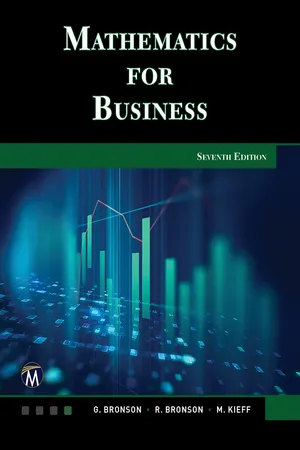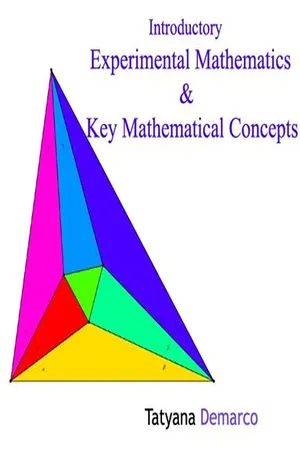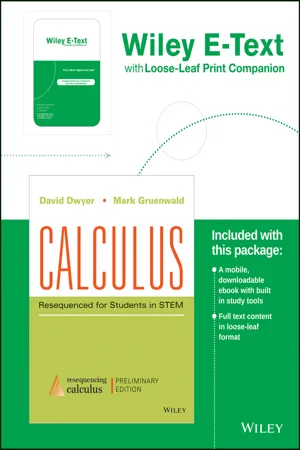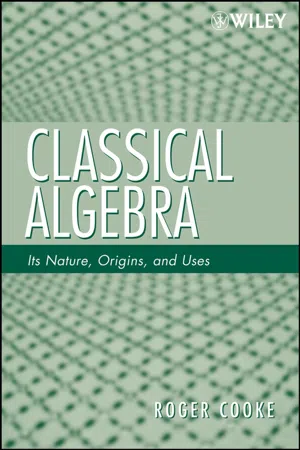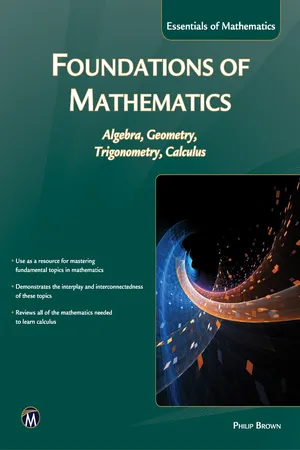Mathematics
Algebraic Functions
Algebraic functions are mathematical functions that can be constructed using a finite number of algebraic operations, such as addition, subtraction, multiplication, division, and taking roots. These functions can be expressed as a ratio of two polynomials and can include constants and variables. They are fundamental in algebra and are used to model various real-world phenomena.
Written by Perlego with AI-assistance
Related key terms
1 of 5
11 Key excerpts on "Algebraic Functions"
- eBook - PDF
Precalculus
Building Concepts and Connections 2E
- Revathi Narasimhan(Author)
- 2016(Publication Date)
- XYZ Textbooks(Publisher)
B oxes can be manufactured in many shapes and sizes. A polynomial function can be used in constructing a box to meet a volume specification. See Example 10 in Section 3.2 for such an application. In this section, we study quadratic, polynomial, and rational functions. These functions have many mathematical properties that play an important role in advanced mathematics and applications. Chapter 3 Outline 10 in. 10 in. 10 – 2 x 10 – 2 x x x x x x x x x 3.1 Quadratic Functions and Their Graphs 3.2 Polynomial Functions and Their Graphs 3.3 Division of Polynomials; the Remainder and Factor Theorems 3.4 Real Zeros of Polynomials; Solutions of Equations 3.5 Complex Numbers 3.6 The Fundamental Theorem of Algebra; Complex Zeros 3.7 Rational Functions 3.8 Quadratic, Polynomial, and Rational Inequalities Polynomial and Rational Functions 3 . 1 3.1 Quadratic Functions and Their Graphs 209 In Chapter 2, you examined linear functions, which are of the form f ( x ) = mx + b . The graph of a linear function is simply a line. In this section, we examine quadratic functions , in which the independent variable x is raised to the second power. Definition of a Quadratic Function A function f is a quadratic function if it can be expressed in the form f ( x ) = ax 2 + bx + c where a , b , and c are real numbers and a ≠ 0. The domain of a quadratic function is the set of all real numbers. Throughout our discussion, a is the coefficient of the x 2 term; b is the coefficient of the x term; and c is the constant term. To better understand quadratic functions, it is helpful to look at their graphs. We study the graphs of general quadratic functions by first examining the graph of the function f ( x ) = ax 2 , a ≠ 0. We will later see that the graph of any quadratic function can be produced by a suitable combination of transformations of this graph. Consider the quadratic functions f ( x ) = x 2 , g ( x ) = − x 2 , and h ( x ) = 2 x 2 . - eBook - PDF
- R. Gustafson, Jeff Hughes(Authors)
- 2016(Publication Date)
- Cengage Learning EMEA(Publisher)
389 4 In this chapter, we continue our study of functions and analyze polynomial and rational functions. We will develop methods to find zeros of polynomial functions of any degree. 4.1 Quadratic Functions 4.2 Polynomial Functions 4.3 The Remainder and Factor Theorems; Synthetic Division 4.4 Fundamental Theorem of Algebra and Descartes’ Rule of Signs 4.5 Zeros of Polynomial Functions 4.6 Rational Functions Chapter Review Chapter Test Polynomial and Rational Functions Careers and Mathematics: Applied Mathematician Applied mathematicians use theories and techniques, such as computational methods and mathematical modeling, to formulate and solve practical problems that arise in engineer- ing, business, science, govern- ment, as well as in the social, life, and physical sciences. Applications are diverse and range from analyzing the effects and safety of new drugs to determining the most efficient way to schedule airline routes between cities. Education and Mathematics Required ● In general, a Ph.D. in mathematics is required for jobs other than those in the federal government. ● College Algebra; Trigonometry; Calculus I, II, III; Linear Algebra; Ordinary Differential Equations; Real Analysis; Abstract Algebra; Theory of Analysis; and Complex Analysis form a basic list. Most mathematicians will study additional topics in their area of specialty. How Applied Mathematicians Use Math and Who Employs Them ● Mathematical theories, algorithms, computational techniques, and computer technology can be used to solve economic, scientific, engineering, and business problems. ● A large number of mathematicians work for the federal government, with about 80% of those working for the U.S. Department of Defense. There are also positions in NASA. Many math- ematicians are employed by universities as faculty members and divide their time between teach- ing and research. Mathematicians are also employed by research-and-development laboratories as part of technical teams. - No longer available |Learn more
- Gary Bronson, Richard Bronson, Maureen Kieff(Authors)
- 2021(Publication Date)
- Mercury Learning and Information(Publisher)
3FUNCTIONSIn this Chapter3.1 Concept of a Function3.2 Mathematical Functions3.3 Polynomial Functions3.4 Quadratic Functions3.5 Exponential Functions3.6 Summary of Key Points3.7 Chapter Appendix: The Quadratic FormulaLinear equations, which were presented in Chapter 2 , are a special case of a broader class of equations known as polynomials. Even though some of the most important business applications can be modeled using linear equations, there are other applications, notably in statistics and marketing that require these more complex polynomials. Additionally, the basics of most financial applications rely on an entirely different class of equations, known as exponentials. A key concept underlying both polynomial and exponential equations, as well as almost all other equations used in business, is a function.This chapter begins with describing what a function is and how it relates to mathematical equations. This is followed by a detailed presentation of polynomial functions, quadratic functions, which, like linear equations are a particular type of polynomial, and exponential functions.3.1 CONCEPT OF A FUNCTIONWhen mathematics is used to model real-world conditions, it must account for relationships between quantities. For example, the growth of bacteria over time, the amount of sales that follow from a given advertising budget, or the increase in the amount earned when a sum of money is invested in a bond.As an example, Table 3.1 illustrates a relationship between the number of cars sold over time, from 2016 to 2021 by Village Distributors, a small new car dealer. Each year’s sales are arranged under the corresponding year, which clearly shows the relationship between the two quantities, year and number of cars’ sold.TABLE 3.1 Yearly Car Sales by Village Distributors.Year 2016 2017 2018 2019 2020 2021 Cars Sold 160 145 155 102 95 151 Now consider Report 3.1, which is both wordier than Table 3.1 - No longer available |Learn more
- (Author)
- 2014(Publication Date)
- Orange Apple(Publisher)
A formal quotient of polynomials, that is, an expression in the form of a fraction where the numerator and denominator are polynomials, is called a rational expression or an algebraic fraction and is not, in general, a polynomial. Division of a polynomial by a number, however, does yield another polynomial. For example, is considered a valid term in a polynomial (and a polynomial by itself) because it is equivalent to and is just a constant. When this expression is used as a term, its coefficient is therefore . For similar reasons, if complex coefficients are allowed, one may have a single term like (2 + 3 i ) x 3 ; even though it looks like it should be expanded to two terms, the complex number 2 + 3 i is one complex number, and is the coefficient of that term. is not a polynomial because it includes division by a non-constant polynomial. is not a polynomial, because it contains a variable used as exponent. Since subtraction can be replaced by addition of the opposite quantity, and since positive whole number exponents can be replaced by repeated multiplication, all polynomials can be constructed from constants and variables using only addition and multiplication. Polynomial functions A polynomial function is a function that can be defined by evaluating a polynomial. A function ƒ of one argument is called a polynomial function if it satisfies ________________________ WORLD TECHNOLOGIES ________________________ for all arguments x , where n is a non-negative integer and a 0 , a 1 , a 2 , ..., a n are constant coefficients. For example, the function ƒ , taking real numbers to real numbers, defined by is a polynomial function of one argument. Polynomial functions of multiple arguments can also be defined, using polynomials in multiple variables, as in An example is also the function f ( x ) = cos(2arccos( x )) which, although it doesn't look like a polynomial, is a polynomial function since for every x it is true that f ( x ) = 2 x 2 − 1 . - eBook - PDF
Calculus
Resequenced for Students in STEM
- David Dwyer, Mark Gruenwald(Authors)
- 2017(Publication Date)
- Wiley(Publisher)
. ., a n are real numbers (called coefficients), and a n 6= 0. Note that a polynomial function of degree 1 has the form f (x) = a 1 x+a 0 , and its graph is a line with slope a 1 and y-intercept a 0 . Thus, we see that linear functions are also polynomial functions. The simplest nonlinear polynomial functions are the quadratic functions, which have the form f (x) = a 2 x 2 + a 1 x + a 0 and are of degree 2. The graphs of quadratic functions are parabolas. Cubic functions have the form f (x) = a 3 x 3 + a 2 x 2 + a 1 x + a 0 and are of degree 3. Two useful examples of quadratic and cubic polynomials are y = x 2 and y = x 3 , the graphs of which are shown in Figures 1.15 and 1.16. -4 -3 -2 -1 1 2 3 4 -4 -3 -2 -1 1 2 3 4 y = x 2 Figure 1.15 -4 -3 -2 -1 1 2 3 4 -4 -3 -2 -1 1 2 3 4 y = x 3 Figure 1.16 Polynomial functions are defined for all real numbers, and so their domain is (-∞, ∞). Their graphs have no breaks and are “smooth” in the sense that there are no abrupt changes in direction. Because of their simplicity, their variety, and the smoothness of their graphs, polynomials are often used to construct mathematical models of real-world phenomena. Rational Functions When two polynomial are added, subtracted, or multiplied, the result is again a polynomial. However, when one polynomial is divided by another, the result is generally not a polynomial. Thus, quotients of polynomials form a new class of functions, called the rational functions. We make the following definition. 1.2. LIBRARY OF FUNCTIONS 17 Definition of Rational Function A rational function is a function of the form f (x) = p(x) q(x) where p(x) and q(x) are both polynomials. Note that by taking q(x) to be the constant function q(x) = 1, we see that a polynomial function can also be viewed as a rational function. More generally, if a rational function has a denominator that is never zero, the function will have some of the same nice properties that polynomials have. - eBook - PDF
Classical Algebra
Its Nature, Origins, and Uses
- Roger L. Cooke(Author)
- 2008(Publication Date)
- Wiley-Interscience(Publisher)
The examples of the quadratic and cubic formulas illustrate some general features of any formula for finding the roots of a polynomial: 1. The formula is a multi-valued function when expressed in terms of t,hc coefficients, that is, it contains radicals. 2. Each radical in the forrnula is a polynoniial when expressed iii terms of the roots. 3. The different values the formula can assume when different choices are made for the values of’ the radicals in it correspond to permutations of the roots of the polynomial. This correspondence between the allowable values of a radical in the cod- ficierits and the permutations of the roots lies at the heart, of the general problem of solving equations algebraically. 118 10. EXISTENCE AND CONSTRUCTIBILITY OF ROOTS 2.3. Algebraic Functions and algebraic formulas. The fuiict,ions that we have displayed here as solutions of the general quadratic and cubic eqiia- tions are called Algebraic Functions of their variables, in analogy with the algebraic numbers that, we discussed in Lesson 1. Each function that we have exhibited is expressible using a finite number of rational operations and root extractions. We warned the reader in Lesson 1 that not all alge- braic numbers can be generated from the integers or rational numbers in this way, and the same is true of algebraic fiinctions. O? where p(a, 6 , c, d , e, f ) is a nonzero polynonlial in its six varkbles, is by defi- nition an algebraic function of its five variables. Thus, a root of the general quintic equation is an algebraic function of the coefficients. But there is a difference between an implicitly expressed algebraic function and an explic- itly expressed algebraic formula. This particular algebra,ic function is not expressible as an algebraic formula using only a finite number of algebraic operations on the coefficients. That is the content of Abel’s theorem, which we are about to explore. - eBook - ePub
Making Sense of Mathematics for Teaching High School
Understanding How to Use Functions
- Edward C. Nolan, Juli K. Dixon, Farhsid Safi, Erhan Selcuk Haciomeroglu(Authors)
- 2016(Publication Date)
- Solution Tree Press(Publisher)
These questions will be addressed as you continue to consider the significance of exploring concepts before procedures and the importance of having multiple approaches in order to reason with mathematics. In the next chapter, you transition from exploring tasks in context to modeling tasks using your knowledge of mathematics. Throughout this book, the perspective is consistent that concepts should be discussed before—but not in place of—procedures. Once a conceptual understanding has been emphasized, procedures and strategies are developed that support mathematical thinking.The ProgressionSimilar to geometry, mathematical concepts in algebra are built on earlier experiences. Analyzing function types connects to earlier high school coursework. Students first learn about functions and function types using specific numbers and values in table format and examine graphical connections for each function type, as you read in chapters 1 and 2 . As the following progression shows, developing understanding of functions builds on and extends previous knowledge of functions by analyzing additional functions using different representations.■ Analyze functions of different types using multiple representations.■ Create functions that model a relationship between two functions (for example, rational functions).■ Build new functions from existing functions (for example, inverse functions).■ Combine and compose functions to create new functions.High SchoolStudents see and analyze characteristics of linear, quadratic, exponential, logarithmic, rational, and trigonometric functions. A major part of the progression entails the analysis of different function types and the construction of new functions from existing functions. For instance, students explore scenarios in which two linear functions are multiplied together. Eventually, they investigate contexts in which two linear functions are divided to create rational functions, which is an extension of students’ study of proportional reasoning from the middle grades.By understanding multiple representations of functions, students begin to appeal to different aspects of functions to deepen their understanding. They use the ideas of the algebraic structure of functions to relate quadratic functions with square root functions, exponential functions with logarithmic functions, and rational functions with functions involving polynomials. Similarly, students create new functions from existing functions by extending notions involving x2 or y2 (such as quadratic functions creating parabolas) to graphs that involve both x2 and y2 - eBook - PDF
- Scott A. Taylor(Author)
- 2023(Publication Date)
- American Mathematical Society(Publisher)
Linear algebra classes study linear functions ∶ ℝ → ℝ . In this text, we study functions in complete general- ity. The key concepts from this section are used throughout theoretical and applied mathematics. In Chapter 6 we gave a formal definition of “function” in terms of sets. For most purposes, however, thinking of a function as a particular kind of set is unnec- essary and maybe even more of a hinderance than a help. In what follows, we give a definition of function in terms of predicates and then explore ways of visualizing func- tions, their properties, and their applications. For particular types of functions, such as continuous functions, there are an enormous number of applications, and we cannot possibly do justice to any of them. Definition 8.1 (Function). Let and be sets. A function ∶ → is a predicate, written as = () or () = , in two free variables ∈ and ∈ such that the following conditions hold. • The domain condition. For each ∈ , there exists a ∈ such that = (). • The well-defined condition. If , ∈ and = , then () = (). The set is called the domain of , the set is called the codomain of , and the set range () = { ∈ ∶ ∃ ∈ such that = ()} is called the range or image of . The range of ∶ → is also denoted (somewhat misleadingly) as (). Two functions ∶ → and ∶ → are equal if and only if = , = , and () = () for all ∈ . In Definition 8.1, we could combine the domain and well-defined conditions into the single requirement that for each ∈ there exists a unique ∈ with = (). The way we have stated the definition, however, is a better guide for constructing proofs involving functions. One popular metaphor is that a function is a machine for converting inputs to outputs. The domain is the set of all potential inputs to . The domain condition requires that all potential inputs are indeed valid inputs. - eBook - PDF
- Mary Jane Sterling(Author)
- 2022(Publication Date)
- For Dummies(Publisher)
Whether you’re graphing rational functions by hand (yes, of course, it’s holding a pencil) or with a graphing calculator, you need to be able to recognize their various characteristics (domain, intercepts, asymptotes, and so on). If you don’t know what these characteristics are and how to find them, your calculator is no better than a paperweight to you. Chapter 10 IN THIS CHAPTER » Covering the basics of rational functions » Identifying vertical, horizontal, and oblique asymptotes » Spotting removable discontinuities in rational graphs » Edging up to rational limits » Taking rational cues to sketch graphs 272 UNIT 2 Figuring on Functions Exploring the Domain and Intercepts of Rational Functions You see rational functions written, in general, in the form of a fraction: y f x g x ( ) ( ) , where f and g are polynomials (expressions with whole-number exponents; see Chapter 9) and g cannot be equal to 0. Rational functions (and more specifically their graphs) are distinctive because of what they do and don’t have. The graphs of rational functions do have helpers called asymptotes (lines drawn in to help with the shape and direction of the curve), and the graphs often don’t have all the real numbers in their domains. Polynomials and exponential functions (which I cover in Chapters 9 and 11, respectively) make use of all the real numbers — their domains aren’t restricted. Sizing up domain As I explain in Chapter 7, the domain of a function consists of all the real numbers that you can use in the function equation. Values in the domain have to work in the equation and avoid producing imaginary or nonexistent answers. You write the equations of rational functions as fractions — and fractions have denomina- tors. The denominator of a fraction can’t equal zero, so you exclude anything that makes the denominator of a rational function equal to zero from the domain of the function. - eBook - PDF
- Daniel Ashlock, Colin Lee(Authors)
- 2022(Publication Date)
- Springer(Publisher)
85 C H A P T E R 7 Functions While every reader of this text is likely familiar with functions such as a quadratic function like f .x/ D x 2 C 2x C 1, this is likely a student’s first real introduction to abstract mathematical functions (or set theoretic functions). In more advanced mathematics the set theoretic defini- tion of functions is used as the default definition of a function. In this section we will define functions and extend much of our ability to work with sets to infinite sets. There are a number of different types of functions and so this section contains a great deal of terminology. Recall that two finite sets are the same size if they contain the same number of elements. It is possible to make this idea formal by using functions and, once the notion is formally defined, it can be applied to infinite sets. 7.1 MATHEMATICAL FUNCTIONS Definition 7.1 An ordered pair is a collection of two elements with the added property that one element comes first and one element comes second. The set containing only x and y (for x ¤ y ) is written fx; y g. The ordered pair containing x and y with x first is written .x; y/. Notice that while fx; xg is not a well-defined set, .x; x/ is a well-defined ordered pair because the two copies of x are different by virtue of coming first and second. The reason for defining ordered pairs at this point is that it permits us to make an important formal definition that pervades the rest of mathematics. Definition 7.2 A function f with domain S and range T is a set of ordered pairs .s; t/ with first element from S and second element from T that has the property that every element of S appears exactly once in some ordered pair. We write f W S ! T for such a function. We say f is a mapping of S to T , or that f maps S to T . Example 7.3 Suppose that A D fa; b; c g and B D f0; 1g then f D f.a; 0/; .b; 1/; .c; 0/g - No longer available |Learn more
Foundations of Mathematics
Algebra, Geometry, Trigonometry and Calculus
- Philip Brown(Author)
- 2016(Publication Date)
- Mercury Learning and Information(Publisher)
In section 5.3, we explain how the graph of a function can be generated from a table of values, and this can, in fact, be used to generate the graph of an equation, an example of which is given in section 5.3.1. A simple test, described in section 5.3.2, called the vertical line test, can be used to decide whether any given graph can be considered the graph of a real-valued function. The types of real-valued function that we introduce in this chapter are the absolute value function (in section 5.4), exponential functions (in section 5.5), root functions (in section 5.7), rational functions (in section 5.6), and logarithmic functions (in section 5.13.2). Piecewise defined functions, introduced in section 5.8, are a means to draw more complicated graphs and also, as we will see in chapter 7 a means to understand the left and right limits. Functions can also be regarded as elements of an algebra of functions, that is, as explained in section 5.10, functions can be added, subtracted, divided, and multiplied together. In other words, it is possible to operate on functions with the same operations that are performed with real numbers. Functions can also be composed with each other as a way of linking functions together, so that the output of one function is the input for another function. Transformations of functions, including vertical and horizontal shifts, vertical and horizontal scaling, and reflections across the axes, are introduced in section 5.11. There arise situations where we would like to describe figures (think of spirals, loops, and flowers) in the plane that cannot be described as the graphs of real-valued functions. Vector-valued functions, introduced in section 5.12, differ from real-valued functions in that a value in the domain is mapped to a vector (a pair of real numbers) rather than a single real number
Index pages curate the most relevant extracts from our library of academic textbooks. They’ve been created using an in-house natural language model (NLM), each adding context and meaning to key research topics.


